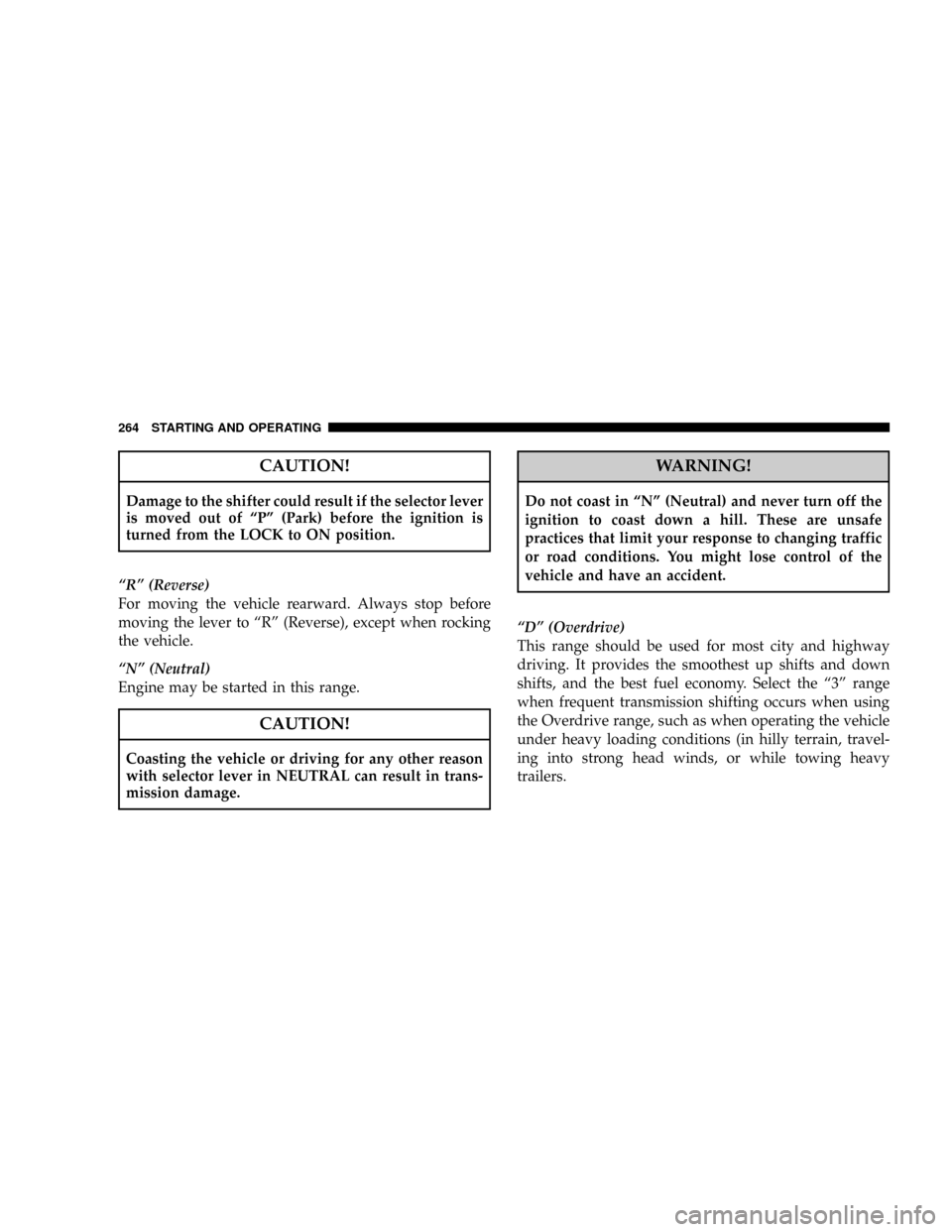Page 180 of 466

This feature allows you to monitor when the MDS
switches off the fuel on four of the eight cylinders and it
can be used to modify driving habits in order to increase
the time in which the fuel saver mode is active.²Distance To Empty (DTE)
Shows the estimated distance that can be traveled with
the fuel remaining in the tank. This estimated distance is
determined by a weighted average of the instantaneous
and average fuel economy, according to the current fuel
tank level. DTE cannot be reset through the FUNCTION
SELECT button.
NOTE:Significant changes in driving style or vehicle
loading will greatly affect the actual drivable distance of
the vehicle, regardless of the DTE displayed value.
²When the DTE value is less than 30 miles (48 km)
estimated driving distance, the DTE display will
change to a text display of9LOW FUEL.9This display
will continue until the vehicle runs out of fuel. Adding
a significant amount of fuel to the vehicle will turn off
the9LOW FUEL9text and a new DTE value will
display.
8 Cylinder Operation - MDS Off
180 UNDERSTANDING YOUR INSTRUMENT PANEL
Page 240 of 466

Blower Control
The rotary knob on the left controls the
blower. The control has an OFF posi-
tion and four speed settings.The
blower will remain on until the con-
trol is turned to the OFF position or
the ignition is turned OFF.
Temperature Control
The rotary knob in the center controls
air temperature. Rotate the control to
the left for cooler air temperature and
to the right for warmer air tempera-
ture. Rotating the control to the ex-
treme left provides the coldest setting.
Rotating the control to the extreme
right provides the warmest setting.
Mode Control
The rotary knob on the right controls
airflow distribution. Dots between
each of the mode selections identify
intermediate modes that allow the op-
erator to fine-tune airflow distribu-
tion. The mode settings are as follows:
²Defrost
Air is directed to the windshield through the
outlets at the base of the windshield. Air is also
directed to the front door windows through the side
window demister grilles.
NOTE:To improve fuel economy, leave in defrost only
when necessary.
²Defrost/Floor
Air flows through the front and rear floor outlets
and the outlets at the base of the windshield. Air
240 UNDERSTANDING YOUR INSTRUMENT PANEL
Page 253 of 466

NCompact Spare Tire Ð If Equipped.........302
NLimited Use Spare Ð If Equipped.........302
NTire Spinning........................303
NTread Wear Indicators..................304
NLife Of Tire.........................304
NReplacement Tires.....................305
NAlignment And Balance.................306
mSelf-Sealing Tires Ð If Equipped............307
mTire Chains...........................307
mSnow Tires...........................308
mTire Rotation Recommendations............308
mTire Pressure Monitor System (TPMS) Ð
If Equipped...........................309NBase System Ð If Equipped..............312
NPremium System Ð If Equipped..........314
NGeneral Information...................318
mFuel Requirements......................319
N2.7L Engine.........................319
N3.5L And 5.7L Engines..................319
NReformulated Gasoline.................320
NGasoline/Oxygenate Blends..............320
NMMT In Gasoline.....................321
NMaterials Added To Fuel................321
NFuel System Cautions..................321
NCarbon Monoxide Warnings..............322
mAdding Fuel..........................323
STARTING AND OPERATING 253
5
Page 254 of 466
NFuel Filler Cap (Gas Cap)...............323
NLoose Fuel Filler Cap Message............325
mVehicle Loading........................326
NVehicle Certification Label...............326
NGross Vehicle Weight Rating (GVWR).......326
NGross Axle Weight Rating (GAWR).........326
NOverloading.........................327
NLoading............................327
mTrailer Towing.........................329
NCommon Towing Definitions.............329NTrailer Hitch Classification...............333
NTrailer Towing Weights (Maximum Trailer
Weight Ratings)......................333
NTrailer And Tongue Weight..............335
NTowing Requirements..................336
NTowing Tips.........................341
mRecreational Towing (Behind Motorhome, Etc.) . . 342
NTowing This Vehicle Behind Another Vehicle
(Flat Towing With All Four Wheels On The
Ground)............................342
254 STARTING AND OPERATING
Page 257 of 466

If Engine Fails To Start
WARNING!
²Never pour fuel or other flammable liquids into
the throttle body air inlet opening in an attempt
to start the vehicle. This could result in a flash
fire causing serious personal injury.
²Do not attempt to push or tow your vehicle to get
it started. Vehicles equipped with an automatic
transmission cannot be started this way. Un-
burned fuel could enter the catalytic converter
and once the engine has started, ignite and
damage the converter and vehicle. If the vehicle
has a discharged battery, booster cables may be
used to obtain a start from a booster battery or
the battery in another vehicle. This type of start
can be dangerous if done improperly. Refer to
Section 6 of this manual for proper jump starting
procedures and follow them carefully.
If the engine fails to start after you have followed the
ªNormal Startingº or ªExtreme Cold Weatherº proce-
dures, it may be flooded. To clear any excess fuel, push
the accelerator pedal all the way to the floor and hold it.
Then, turn the ignition switch to the START position and
release it as soon as the starter engages. The starter motor
will disengage automatically in 10 seconds. Once this
occurs, release the accelerator pedal, turn the ignition
switch to the LOCK position, wait 10 to 15 seconds, then
repeat the normal starting procedure.
CAUTION!
To prevent damage to the starter, wait 10 to 15
seconds before trying again.
STARTING AND OPERATING 257
5
Page 264 of 466

CAUTION!
Damage to the shifter could result if the selector lever
is moved out of ªPº (Park) before the ignition is
turned from the LOCK to ON position.
ªRº (Reverse)
For moving the vehicle rearward. Always stop before
moving the lever to ªRº (Reverse), except when rocking
the vehicle.
ªNº (Neutral)
Engine may be started in this range.
CAUTION!
Coasting the vehicle or driving for any other reason
with selector lever in NEUTRAL can result in trans-
mission damage.
WARNING!
Do not coast in ªNº (Neutral) and never turn off the
ignition to coast down a hill. These are unsafe
practices that limit your response to changing traffic
or road conditions. You might lose control of the
vehicle and have an accident.
ªDº (Overdrive)
This range should be used for most city and highway
driving. It provides the smoothest up shifts and down
shifts, and the best fuel economy. Select the ª3º range
when frequent transmission shifting occurs when using
the Overdrive range, such as when operating the vehicle
under heavy loading conditions (in hilly terrain, travel-
ing into strong head winds, or while towing heavy
trailers.
264 STARTING AND OPERATING
Page 266 of 466

Torque Converter Clutch
A feature designed to improve fuel economy has been
added to the automatic transmission of this vehicle. A
clutch within the torque converter engages automatically
at calibrated speeds. This may result in a slightly differ-
ent feeling or response during normal operation in high
gear. When the vehicle speed drops, or during accelera-
tion, the clutch automatically and smoothly disengages.
NOTE:
²The torque converter clutch will not engage until the
transmission fluid and engine coolant is warm (usu-
ally after 1±3 miles [1.6±4.8 km] of driving). Because
engine speed is higher when the torque converter
clutch is not engaged, it may seem as if the transmis-
sion is not shifting into ªOverdriveº when cold. This is
considered a normal condition. Pulling the selector
lever into the ª3º position will show that the transmis-
sion is able to shift into and out of ªOverdrive.º
²If the vehicle has not been driven for several days, the
first few seconds of operation after shifting the trans-
mission into gear may seem sluggish. This is due to the
transmission fluid partially draining from the torque
converter into the transmission. This is considered a
normal condition and it will not cause damage to the
transmission. The torque converter will refill within 5
seconds of shifting from ªPº (Park) into any other gear
position.
Transmission Limp Home Mode
The transmission is monitored for abnormal conditions.
If a condition is detected that could cause damage, the
transmission automatically shifts into second gear. The
transmission remains in second gear despite the forward
gear selected. ªPº (Park), ªRº (Reverse), and ªNº (Neu-
tral) will continue to operate. This Reset feature allows
the vehicle to be driven to a dealer for service without
damaging the transmission.
266 STARTING AND OPERATING
Page 270 of 466

ªDº (Drive)
This range should be used for most city and highway
driving. It provides the smoothest upshifts and down-
shifts and the best fuel economy.
The transmission automatically upshifts through fifth
gear. The ªDº (Drive) position provides optimum driving
characteristics under all normal operating conditions.
When frequent transmission shifting occurs when using
the Overdrive range, such as when operating the vehicle
under heavy loading conditions (in hilly terrain, travel-
ing into strong head winds, or while towing heavy
trailers, use the AutoSticktmode and select the ª3º
range.
AutoSticktGear selection
The AutoSticktfeature can be selected by pressing the
selector lever to the right or the left with the lever in the
ªDº (Drive) position. The gear currently selected is
indicated in the instrument cluster display. Briefly, pressthe selector lever in the ªD -º direction and the transmis-
sion will shift from the current gear to the next lower
gear.
Press and hold the selector lever in the ªD-º direction and
the transmission will shift from the current gear directly
to the next lowest gear for best acceleration.
NOTE:To avoid overrevving the engine when the
selector lever is moved in ªD -º direction, the transmis-
sion will not shift to a lower gear if the engine's revolu-
tions per minute (RPM) limit would be exceeded.
Briefly, press the selector lever in the ªD +º direction and
the transmission will shift from the current gear to the
next higher gear.
Press and hold the selector lever in the ªD +º direction
and the transmission will shift from the current gear
directly to gear ªD.º
270 STARTING AND OPERATING